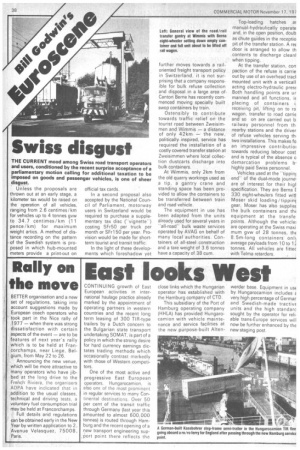Swiss disgust
Page 42

If you've noticed an error in this article please click here to report it so we can fix it.
THE CURRENT mood among Swiss road transport operators and users, conditioned by the recent surprise acceptance of a parliamentary motion calling for additional taxation to be imposed on goods and passenger vehicles, is one of sheer disgust.
Unless the proposals are thrown out at an early stage, a kilometer tax would be raised on the operation of all vehicles, ranging from 2.6 centimes/km for vehicles up to 4 tonnes gvw to 34.7 centimes/km (11 pence/km) for maximum weight artics. A method of distance recording on the pattern • of the Swedish system is proposed in which hub-mounted meters provide a print-out on official tax cards.
In a second proposal also accepted by the National Council of Parliament, motorway users in Switzerland would be required to purchase a supplementary tax disc ("vignette.") costing SFr50 per truck per month or SFr150 per year. Provision would be made for shortterm tourist and transit traffic.
In the light of these developments which foreshadow yet further moves towards a railoriented freight transport policy in Switzerland, it is not surprising that a company responsible for bulk refuse collection and disposal in a large area of. Canton Berne has recently commenced moving specially built swop containers by train.
Ostensibly to contribute towards traffic relief on the tourist road between Zweisimmen and Wimmis — a distance of only 42km — the new, politically inspired, service has required the installation of a costly covered transfer station at Zweisimmen where local collection dustcarts discharge into bulk containers.
At Wimmis, only 2km from the old quarry workings used as a tip, a gantry crane and standing space has been provided to allow the containers to be transferred between train and road vehicle.
The equipment in use has been adapted from the units already used for several years in "all-road" bulk waste services operated by AVAG on behalf of many local authorities. Containers of all-steel construction and a tare weight of 3.6 tonnes have a capacity of 38 cum. Top-loading hatches al manual-hydraulically operate and, in the open position, doub as chute guides in the receptio pit of the transfer station. A re door is arranged to allow th contents to discharge cleanl when tipping.
At the transfer station, con paction of the refuse is carrie Out by use of an overhead tract mounted unit with a verticall acting electro-hydraulic pres( Both handling points are ur manned and all functions, ie placing of containers i receiving pit, lifting on to ra wagon, transfer to road carriE and so on are carried out b railway personnel from th nearby stations and the driver of refuse vehicles serving th two installations. This makes fo an impressive contributioi towards reducing labour cost and is typical of the absence o demarcation problems IT highly paid Swiss personnel.
Vehicles used at the "tippinj endof the dual-mode journe! are of interest for their higl specification. They are Berna 330 eight-wheelers fitted witt Moser skid loading /tippinc gear. Moser has also supplie( the bulk containers and th4 equipment at the transfe points. Although the vehicle! are operating at the Swiss maxi
mum gvw of 28 tonnes, tht 8.5m-long containers onl)
average payloads from 10 to 1: tonnes. All vehicles are fitter with Telma retarders.






























































































































